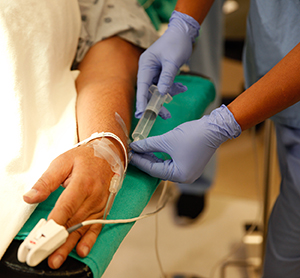Anesthesia: Monitored Anesthesia Care (MAC)
Anesthesia: Monitored Anesthesia Care (MAC)
You’re due to have surgery. During surgery, you’ll be given medicine called anesthesia. This will keep you comfortable and pain-free. Your surgeon will use monitored anesthesia care (MAC). This sheet tells you more about this type of anesthesia.
What is monitored anesthesia care?
MAC keeps you very drowsy during surgery. You may be awake, but you will likely not remember much. And you won’t feel pain. With MAC, medicines are given through an IV line into a vein in your arm or hand. A local anesthetic will usually be injected into the skin and muscle around the surgical site to numb it. The anesthesia provider monitors you during the procedure. He or she checks your heart rate and rhythm, blood pressure, and blood oxygen level.
Anesthesia tools and medicines that may be near you during your procedure
You will likely have:
A pulse oximeter on the end of your finger. This measures your blood oxygen level.
Electrocardiography leads (electrodes) on your chest. These record your heart rate and rhythm.
Medicines given through an IV. These relax you and prevent pain. You may be awake or sleep lightly. If you have local anesthetic, it is injected directly into your skin.
A facemask to give you oxygen, if needed.
Risks and possible complications
MAC has some risks. These include:
Breathing problems
Nausea and vomiting
Allergic reaction to the anesthetic
Anesthesia safety
Tips for anesthesia safety include the following:
Follow all instructions you are given for how long not to eat or drink before your procedure.
Be sure your healthcare provider knows what medicines you take, especially any anti-inflammatory medicine or blood thinners. This includes aspirin and any other over-the-counter medicines, herbs, and supplements.
Have an adult family member or friend drive you home after the procedure.
For the first 24 hours after your surgery:
Do not drive or use heavy equipment.
Do not make important decisions or sign documents.
Avoid alcohol.
Have someone stay with you, if possible. They can watch for problems and help keep you safe.
Updated:
February 01, 2018
Sources:
Monitored Anesthesia Care. Ghise D. Minerva Anestesiologica. 2005;71(9):533-38., Practice advisory for preanesthesia evaluation: an updated report by the American Society of Anesthesiologists Task Force on Preanesthesia Evaluation. Anesthesiology. 2012;116(3):522-38.
Reviewed By:
Image reviewed by StayWell art team.,Sudheendra, Deepak, MD,Taylor, Wanda L, RN, Ph.D.
